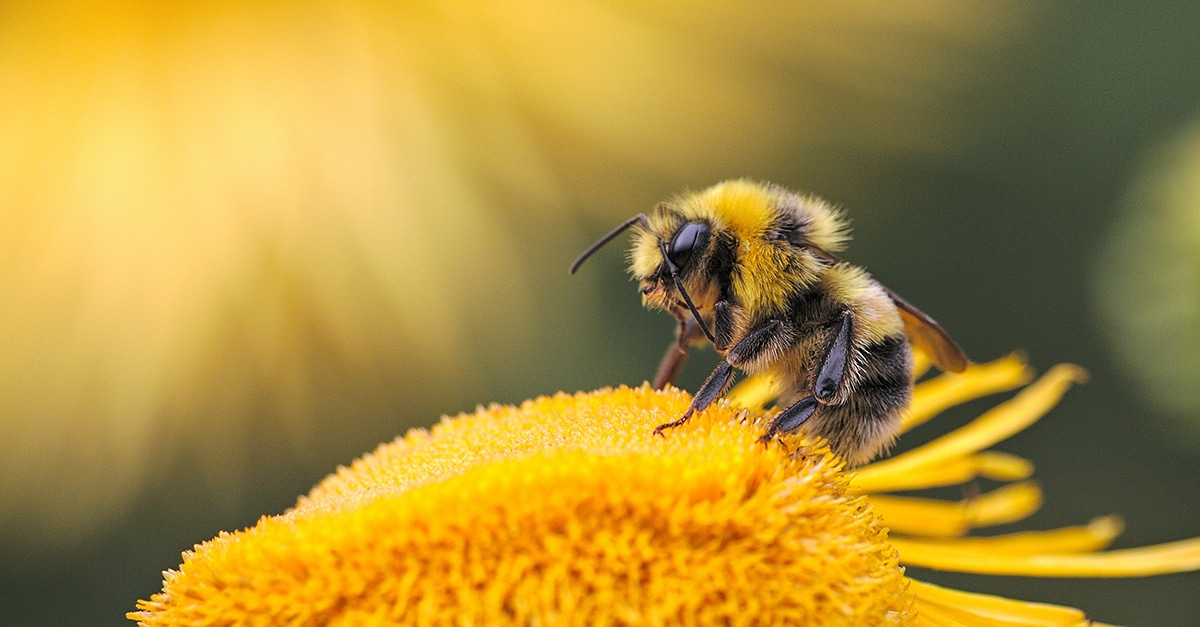Bees are one of the most important species on our planet. They pollinate a third of our food crops and help maintain the diversity of plant species. Before we imported honey bees, all animal pollination in North America was done by native pollinators, including nearly 4,000 species of native bees. (In Missouri, our other pollinators include ants, bats, beetles, butterflies, flies, hummingbirds, moths and wasps.) Animals pollinate 87 percent of all plants on earth. If pollinators disappear, nearly 90 percent of the plants on Earth would disappear. And if that happens, we’ll disappear too, along with most other species.
There is reason to be concerned about our current path. Here in the Midwest, half of our native bee species have disappeared from their historic ranges. Four species of bumblebees have declined 96% (just in the last 20 years) and 1/4 of our bumblebee species are at risk of extinction. So it’s important for us to start paying attention to bees!
OK, BUT! Bees Sting Right?
Yes, but only the females. (Males do not have stingers). And the females only sting in self-defense or in defense of their hive. Interestingly, of all 4000 species of native bees, only bumblebees (46 species) have hives, and they are tiny compared to honey bee hives. All the rest of the native bees are solitary and never aggressively defend a home.
When someone is stung by a bee, it is likely a honey bee that has been stepped on, or is defending its hive. Bees are not at all aggressive while foraging at flowers in our yards – they are too focused on gathering pollen and nectar. In fact, you can walk among flowers crawling with bees and not fear being stung! (You might want to read that sentence again.)
Yellowjackets on the other hand are the source of painful stings, and people frequently mistake yellowjackets for bees. Yellowjackets are predatory wasps. They are not bees and they do not pollinate plants. They are however a social species and they construct large hives in the ground or in trees. They will defend their hives aggressively, and unlike a honey bee, each individual yellowjacket can sting multiple times.
So now that we know we don’t need to be afraid of bees in our gardens, how can we help bees?
Bees Need Shelter
Bees That Nest in The Ground
About 70% of our native bees nest in the ground – others nest in wood, or plant stems or other nooks and crannys. Bumblebees like shallow holes in the ground protected from rain, as well as holes in a rock wall. Ground-nesting bees are easy to help – just leave some bare patches of dry sandy soil in our garden (not hard-packed clay). Patches with a slight southern slope are best.
In the spring look for holes surrounded by small mounds of soil. Each hole is a nest for a single female leading to tunnels with developing bee larva. You can watch the female bees enter and return every few minutes. Avoid walking on the bare patches, don’t mulch, and do not use any lawn fertilizer or other chemicals near bee nests.
Bees That Nest in Perennials
There are other bees that nest in pithy stems of perennials such as goldenrods, blackberries, giant ragweeds and native hydrangeas that are hollow enough for the bees to make nesting cavities. Mason bees, small carpenter bees and small resin bees will construct a sequence of cells inside the stem, each cell packed with pollen and a single egg. In early summer young bees will emerge from the stem by chewing a hole to the outside. If it’s later in the season, the young bee will stay in the stem all winter, and emerge in the spring when the flowers begin to bloom.
Bees That Nest in Wood
There are native bees that nest in wood including carpenter bees and some species of mason bees. They build their nests in soft wood in a downed log or branch, or often in a dead branch still attached to a tree. Mason bees, yellow-faced bees and leafcutter bees will nest in existing cavities.
It’s not hard to help bees that nest in stems, wood and cavities. Most of us have these materials in our yards. But unfortunately, we don’t realize their value. In the fall we “”cleanup” and cut the stems of black-eyed Susans, penstemons, sunflowers and other perennials where baby bees are overwintering. The dead elderberry branch or elm branch that fell during a storm that we tidy-up are now homes for wood nesting bees. Our norm of making our gardens neat and tidy does a number on our native bee populations.
We can help though! If you need to cut off the stems of your perennials in the fall, cut off stems near the ground, and then stand them up for the winter out of view. Heather Holm, an expert on Midwest native bees, has discovered that most bee species that spend the winter in the stalks are within one foot of the ground. So another option is to cut off the stems, but leave the bottom 18″ for the bees. And then leave dead tree branches and logs in your garden for wood nesting bees.
Bee hotels can help increase the nesting capacity in our yards. However by concentrating nesting, large bee hotels actually increase the chance that all the bees will be wiped out by predators, parasites or disease. So if you install bee hotels in your yard, use small ones, with just a few cells each, and don’t concentrate them in one area.
Bees Need To Eat
Bees have to eat every day. Adult bees eat pollen and nectar, while larval bees eat only pollen. Pollen and nectar comes from flowers, so to keep bee populations healthy, we need flowers blooming in our yards throughout the season. a two or three week stretch without blooms can be deadly to bees! Many bee species have evolved to require pollen from particular native plants. So plant natives, and plant a variety for season-long blooms. Be sure to include perennial sunflowers, goldenrod, native willow and asters.




